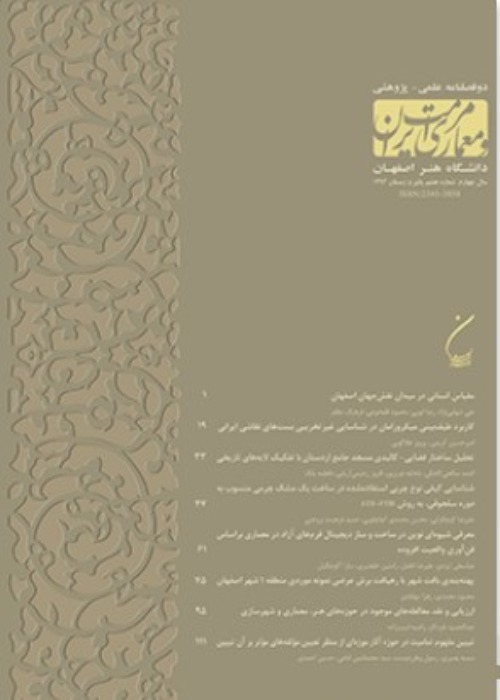Review and study of meaning and function of the words "Tachar" and "Hadish" in the collections of the Achaemenid Persepolis and Susa
Author(s):
Article Type:
Research/Original Article (دارای رتبه معتبر)
Abstract:
Undoubtedly, Achamenid architecture is one of remarkable periods of Iranian architecture, which is apparent in their three cities of Susa, Pasargadae, and Persepolis. Differently, some of the structures have especial labels in inscriptions in Achamenid period. There are considerable numbers of "Tachar" and "Hadish" in Susa and Persepolis, where Achamenid kings characteristically used to call some structures. There have been various researches to recognize architecture of the period, with burdens of linguists to understand ancient Persian; however, there have not been appropriate answers to raised questions, for which researchers explain varieties of reasons and definitions.Some functionally involved in the problem as such, while the others only regard planning patterns. One of the researchers knows "Tachar" predecessor of "Tazar" of modern Persian, while reasons southward plan of the structure accordingly; another one consider "Tachar" as a single object and equals it to palace, at the same time, the other one knows it closet or next house. Several researchers know "Hadish" as residence or home, while the others believe it as predecessor of "Khadish" as dame or queen.However, there is lack comprehensive reasoning on the subject,which is because lack of independent and holistic research. Here, there is an attempt to investigate architectural plan of the structures in order to compare the structures to their labels, and then investigate comprehensively the reason of naming. Methodologically, the paper involves historically and descriptively in whatever data collected bibliographically. The basic question is what is reasoned relation between function and label of the structures?Conclusions indicate that buildings with "Tachar" in their inscriptions are structurally interiorized. However, structural plan is unknown, in some cases, or with ambiguities, they have common structural features. Several scholars suggest a seasonal function for the structures, but it is doubtful while locating in same climate, they face to north, south, and east. Few dictionaries suggest "treasure" for the structures, which is compatible to interiority of the structure. "Hadish" is the ancient Persian form of "Khadish" in Dari Persian as Deam or queen, which functionally is equal to Tachar, accordingly, they usually come one after another in inscriptions. Hadish means residence or seraglio, while Tachar means treasure or closet; they have similar implication and function.That is the reasonthat both used in labeling structures that were residences or courts.Hadish is functionally against Apadana; present paper suggests seraglio or sanctuary as the same function. They were specially used for seclusion of kings or queens of the period, at the same time; it was probably especial residence of queen mother. Present paper indicates that northern half of the Susa and Persepolis complexes worked as exterior and public part, while structure at southern half, especially at western part of Persepolis, and several buildings of southern district worked as seraglio for Achamenis kings
Keywords:
Achamenid architecture , Susa , Persepolis , Tachar , Hadish
Language:
Persian
Published:
Maremat & memari-e Iran, Volume:10 Issue: 17, 2019
Pages:
1 to 20
https://magiran.com/p2015384
دانلود و مطالعه متن این مقاله با یکی از روشهای زیر امکان پذیر است:
اشتراک شخصی
با عضویت و پرداخت آنلاین حق اشتراک یکساله به مبلغ 1,390,000ريال میتوانید 70 عنوان مطلب دانلود کنید!
اشتراک سازمانی
به کتابخانه دانشگاه یا محل کار خود پیشنهاد کنید تا اشتراک سازمانی این پایگاه را برای دسترسی نامحدود همه کاربران به متن مطالب تهیه نمایند!
توجه!
- حق عضویت دریافتی صرف حمایت از نشریات عضو و نگهداری، تکمیل و توسعه مگیران میشود.
- پرداخت حق اشتراک و دانلود مقالات اجازه بازنشر آن در سایر رسانههای چاپی و دیجیتال را به کاربر نمیدهد.
In order to view content subscription is required
Personal subscription
Subscribe magiran.com for 70 € euros via PayPal and download 70 articles during a year.
Organization subscription
Please contact us to subscribe your university or library for unlimited access!



